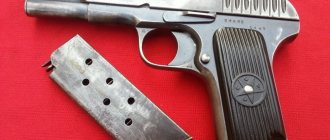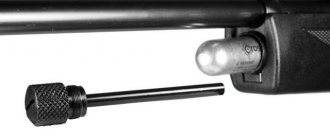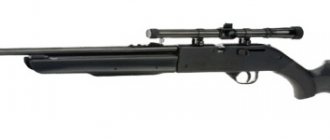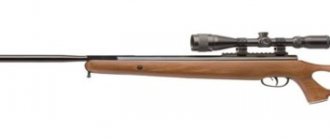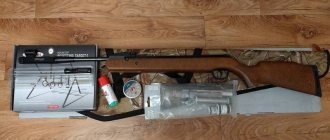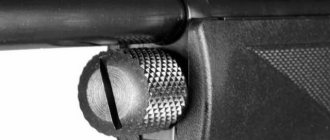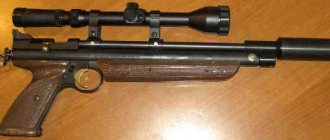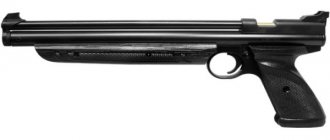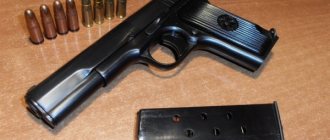Crosman 357 is a pneumatic replica of the iconic Colt Python revolver, which had the 357 Magnum index and was produced in the USA from 1955 to 1996. The model range of the air revolver, produced since 1982, was the same as the prototype: with a barrel length of eight, six and four inches. Since 1992, after restyling, a single model has been produced with a barrel length of 6 inches. The characteristic distinguishing features of the model are a ventilated sighting bar with three oblong holes along the entire length and a large trigger lever on the buttplate of the combat mechanism.
Crosman 357-6 Air Pistol Review
This is a multi-charged revolver-type pneumatic weapon that uses the energy of compressed carbon dioxide from a siphon cartridge to fire. The Crosman shoots 4.5mm bullets. The barrel is rifled. A standard 10-shot drum for multi-shot pneumatics is used. The original one, available from Colt Pihton, is only imitated.
Advantages
The revolver really looks like the original Colt Python.
The technical design of the combat mechanism, which uses carbon dioxide to fire a shot, is well developed and reliable. A 12-gram siphon cartridge was used - the maximum possible for a short-barreled air weapon of this type.
The trigger mechanism is made of steel, the safety is manual, of the simplest design, reliably preventing an accidental shot. There are two ways to cock the hammer - self-cocking and manual. The long rifled barrel ensures good shooting accuracy.
Flaws
The plastic receiver with an inserted steel barrel does not accurately fix the charging chamber opposite the bypass hole. There is no seal on the bypass bushing. These design features often lead to the fact that the revolver begins to “spit” rather than shoot bullets. Especially if more than one drum is shot in a row. It is interesting that in the original Colt Python, during prolonged shooting, the same effect of breakthrough of powder gases was noted.
The Crosman 357 6 revolver is heavy: 910 grams for a design made half of plastic is fantastic. Many shooters note that the handle is too massive and thick, making it uncomfortable to hold.
The original Colt drum is only imitated. The weapon is loaded by breaking the barrel, which is held in place by a simple latch with a weak spring.
Photo of the Crosman 357-6 pneumatic revolver
Application
The revolver is used for recreational and sport shooting. There is an opinion among the airgun community that the Crosman 357 6” is the best revolver for the shooting range.
Description
Crosman 357 is one of the most popular types of air guns in Russia, although it is manufactured in the USA. It is a pneumatic replica of the legendary Colt Python revolver, part of its name "357" it received from the gun index "357 Magnum", which was produced in the USA until 1996. Distinctive features of this model of pneumatic revolver are a large trigger lever on the rear of the mechanism and a sighting bar with 3 holes along the entire length of the barrel.
REFERENCE. The Crosman 357 is a revolver-type repeating airgun that operates using the energy of carbon dioxide filled into a siphon cartridge.
The Crosman 357 revolver uses 4.5 caliber bullets and the cylinder holds 10 rounds. The trigger, trigger, and sides of the handle are painted black, and the rifled barrel, cylinder and clips are gray. In general, the simplicity of the design makes the revolver affordable and attractive in quality.
Design
This pneumatic revolver is equipped with a steel rifled barrel and a carbon dioxide cartridge. This volume can provide the revolver with approximately 60 shots. It can fire both lead bullets and steel balls. The Crosman 357 frame is made of aluminum, and the trigger and all internal parts are made of steel. Since 1992, the revolver casing has been made of plastic, which prevents slipping during training. In previous versions of the weapon, it was made of zinc.
The revolver's safety is made quite reliably, in the form of a special bar that can smoothly move horizontally. With one shift, the trigger falls under the protrusion, but the shot does not occur. It is necessary to move again so that the trigger reaches the valve stem and you can shoot.
The sighting bar is adjustable both horizontally and vertically, but to do this you need to tighten the screws with a screwdriver. The weapon is equipped with external sighting devices - front sight, rear sight and ventilated sighting rib. The front sight of the revolver has a notch that prevents glare. Although the revolver's drum is designed to hold 10 rounds, it can be replaced with a 6-round one by breaking the barrel.
REFERENCE. The Crosman 357 pneumatic revolver is sold in a blister on cardboard with a three-color print and technical specifications in 2 languages.
Performance characteristics
The pneumatic gas-cylinder revolver Crosman 357 has the following tactical and technical characteristics:
| Pneumatic type | gas-cylinder |
| Weapon length, mm | 240 — 290 |
| Height, mm | 160 |
| Weight, kg | 0,78 — 0,91 |
| Barrel length, mm | 100 — 152 |
| Power supply | CO2 cylinder, 12 g. |
| Drum capacity | 6 / 10 shells |
| Number of shots from one cylinder | about 60 |
| Initial bullet speed, m/s | 133 |
| Sighting range, m | 10-15 |
| Bullet type | Lead Airgun Pellet |
| Caliber | 4.5 (.177) |
| Fuse | button |
Specifications
Technical characteristics of the Crosman 357 6 pneumatic revolver:
| Characteristics | Indicators |
| Weapon type | Repeater, revolver |
| Caliber | 4.5 mm |
| False cartridges | No |
| Drum | Standard for multi-shot air rifles, 10-shot capacity |
| Ammunition type | Lead bullet |
| Trunk | Steel, with rifling (10 pieces) |
| Barrel length | 152.4 mm |
| Type of fighting mechanism | Gas cylinder, CO2 |
| Trigger action | Double - self-cocking and manual |
| Gas cartridge (siphon) | 12 grams |
| Initial bullet speed | 140 m/s (JBS ex, weighing 0.51 g) |
| Number of shots from one cylinder | 50–60 |
| total length | 289 mm |
| Weight | 910 grams |
| Handle | With plastic cheeks and two anatomical protrusions for the fingers |
| Color | Black |
Characteristics of the air pistol Crosman SNR357 (4.5 mm)
| Manufacturer | Crosman (USA, Taiwan) |
| Combat prototype | Revolver Smith&Wesson (USA) |
| Type | Gas pneumatics |
| Length (mm) | 206 |
| Speed(m/s) | 121 |
| Type of ammunition | BB, steel balls |
| Barrel type | smooth |
| Muzzle energy (J) | |
| Number of charges (pcs) | |
| Energy source | CO2 canister |
| Blowback | No |
| Housing material | metal |
| Base material | metal |
| Equipment | gun, passport |
| Caliber | 4.5 mm |
| Product weight | 0.91 kg |
Pneumatic revolver Crosman SNR 357 (Smith and Wesson) buy in the Popadiv10 online store. Pneumatic revolver Crosman SNR 357 (Smith and Wesson) at a low price of 12,722 rubles. You can pay for your order by mail upon receipt in any part of the Russian Federation. Before placing an order, be sure to check the price and contents of the product by phone (during business hours) or by e-mail and feedback system (at any time convenient for you).
Information on the product “Pneumatic revolver Crosman SNR 357 (Smith and Wesson)” is for informational purposes only and is not a public offer as defined by the provisions of Article 437 of the Civil Code of the Russian Federation; characteristics, appearance, color and equipment may be changed by the manufacturer without notice.
Design
Massive brutal black revolver. The receiver is plastic, the barrel is steel, with ten spiral rifling, inserted into it and latched with something similar to a paper clip. The ventilated sighting bar with three oblong slots is removable, and underneath there is a tin weighting cylinder. The connection between the receiver and the revolver body is a hinge on one pin located in front of the trigger guard. Fixation - a latch with a triangular tooth, located on the body along the aiming line and actuated by a square button.
Loading - installation of a standard 10-round drum on the axis of the receiver after it has been “broken.” After loading is complete, the locking latch on the case must be “recessed” by pressing a button. The dashing snapping of the barrel, as in Westerns, leads to its breakdown. For shooting, lead bullets of 4.5 mm caliber are used. It is possible to use models with pyrotechnic effects.
The revolver body is made of silumin alloy, the original Colt Python drum is cast in the form of a decorative protrusion on it. The handle pads are plastic, removable, with two anatomical protrusions for the fingers. A CO2 cylinder weighing 12 grams is installed in the handle after they are removed. The clamping screw is hidden under plastic covers.
External sighting device - front sight, rear sight and ventilated sighting rib.
The trigger mechanism is steel, double action. The hammer can be cocked by pressing the trigger or manually using the hammer lever on the buttplate of the combat mechanism. The fuse is the simplest - a transverse metal pin that blocks access of the trigger to the striker of the timing rod. It is turned on and off by sliding the pin to the right or left. The "off" position is indicated by a red dot on its left end.
Well, let's take a closer look at the overseas miracle. First of all, we enter the barcode on the box here https://www.labeltest.com/scodes.php and read <The barcode is genuine! Country of origin: USA and Canada>. However, it’s already nice that it was not produced by our Chinese friends, or at least it was not put in the box in China. We take it out of the packaging and determine the materials from which this device is made. The revolver frame is aluminum alloy, the barrel casing, the cheeks are plastic, the trigger, SC, barrel and other filling parts are steel. The 900 gram revolver fits quite nicely in the hand and does not feel like a toy. It is also worth noting that the revolver’s dimensions are not childish, but if you have an average-sized hand, there should be no inconvenience when holding it. Pictured is a Walter SR88 for comparison.We take aim and carefully examine the sighting devices. Oh, and the rear sight has vertical and horizontal adjustment! With the “current fashion”, on devices twice as expensive, manufacturers do not bother making an adjustable rear sight. We turn the rear sight screws with a screwdriver, of course there are no clicks, but there is completely no play, i.e. Having configured it once, you don’t have to worry about it in the future. There is one peculiarity in adjusting the rear sight height - to raise the rear sight, you do not need to unscrew the screw (as usual everywhere), but tighten it. But this is not a problem and does not cause inconvenience. The front sight has a notch and does not glare when aiming. Conclusion - really normal sighting devices that will allow you to accurately shoot not only at cans, but also at targets on paper.
We press the barrel latch and open it for loading (removing the drum). This action is very convenient to do with the thumb of your left hand, holding the barrel itself with your palm. We look into the barrel itself - it is steel, with 10 fairly decent grooves and unpolished fields. The lead-in chamfer is increased to compensate for the misalignment of the drum. The muzzle chamfer is purely symbolic, but I think in its present form it will not have an unambiguous effect on accuracy - it’s just that the design of the revolver itself is not conducive to high shooting accuracy, but looking ahead, we can say that everything is not bad at all!
By the way, I decided to clean the barrel. And I accidentally removed it without a single tool. It is enough to press a little with your finger on the muzzle and stupidly pull it out past the bullet entrance, slightly holding the barrel latch so that it does not warp when removing it. At the same time, the ventilated bar with the front sight was also removed. Respect to the technologists - it is simple and cheap to produce, and convenient for the user to maintain.
We take out the drum. It has 10 charges. When loading, I recommend pushing each bullet into the chamber (this should generally be done on all pneumatic devices with a drum and I wrote this earlier in other topics), for example, with a fountain pen. This will allow the revolver's spring-loaded seal to press more accurately into the cylinder chamber before firing. In general, the accuracy will definitely be higher.
Remove the cheeks and insert the balloon. The cheeks themselves “grin” a little on the frame of the revolver without a cylinder, however, when installing the cylinder, this jamb is almost unnoticeable and does not in any way interfere with shooting. Installing the cylinder is very simple - insert the cylinder and tighten the clamping screw. We fired 70 rounds, removed the cheeks and released the clamping screw. When unscrewing, it can be a bit difficult, but you can always help yourself with a small flat screwdriver by inserting it into the gap of the “thumb” through which the clamping screw is tightened and unscrewed.
To start shooting, the revolver must be removed from the safety. It is quite primitive, but very reliable. When turned on, it prevents the revolver trigger from striking the valve stem.
The revolver allows you to shoot both pre-cocked and self-cocked. I noticed an interesting feature. We cock the hammer and the trigger moves towards the frame of the revolver, where the sear protrudes. I tried, without pressing the trigger, to press it lightly with a screwdriver - it fired. Figuratively speaking, if you saw off the trigger, you can still shoot from pre-cocking.
The external inspection is completed, now you can shoot. The indoor shooting distance is 5-5.5 meters. JSB Exakt, JSB Express, RWS SuperField, RWS R10, CP 7.9 were shot from a revolver from a cardboard box. Guess which bullets were most accurate from this revolver? That's right, the most budget CP7.9, which can drive the entire drum from a given distance of 15 mm. Those. Crosman bullets and Crosman revolver suited each other perfectly. I plan to try shooting GamoRound bullets. It seems to me that they should also fly well, for shooting at beer cans.
Here are the pictures...each target has 10 bullets
Well, here comes CP7.9. I note that they fly significantly lower than the previous ones. Therefore, on the first target the “ten” was lower, and on the second I raised the rear sight. And most importantly, do not judge strictly - all actions take place two hours before the New Year...i.e. I was sufficiently fueled
Conclusion: For the money for which the revolver was purchased, this is the best I have had in terms of price-quality ratio in “new from the store” condition. The revolver has an unpretentious design, is easy to handle, you can carry it in your pocket and belt, or stupidly just drop it in a puddle (but you don’t need to do this) - it’s not a pity! At the same time, its performance characteristics allow you to train at home when shooting at targets, and on the street you can shoot beer cans at 10-15 meters and there will be no misses due to the fault of the revolver. Yes, and beer and vodka glass containers with such performance characteristics will not stand at 10 meters either, but we love nature... our mother... and therefore we will not shoot at glass
PS There is no need to make any upgrades to the revolver - it is good as is and is not worth wasting precious time that can be used for more important matters.
Operating principle
Loading begins with the installation of 4.5 mm lead rifle bullets into a serrated removable drum. After this, pressing the button on the aiming line of the revolver releases the receiver. Having broken it, put the loaded drum on the pin and snap the receiver onto the revolver body. When fixing the receiver to the revolver body, do not forget to recess the latch button. There is no need to calculate the moment of the bullet’s position opposite the muzzle of the barrel. This happens automatically.
Remove both pads from the handle (otherwise you will not have access to the thumbscrew) and install the siphon bottle with the neck up. Tighten the clamping screw until a characteristic hissing sound appears and install the pads in place. The revolver is almost ready to fire.
By sliding the safety pin (located on the buttplate of the combat mechanism) to the left until a red dot appears at the end, cock the trigger mechanism. This can be done by pressing the trigger or cocking the hammer lever. In the first case, the force of pressing the trigger until the shot is fired will be long and equal to 3.2 kilograms, in the second - fast and soft. Each movement of the trigger to cock is accompanied by a synchronized rotation of the charging drum, which sends the bullet to the muzzle of the barrel, and its pressing towards the receiver.
After the clamping screw pins the cylinder onto the needle of the expansion chamber, it is partially filled with carbon dioxide. It is held in place by a spring-loaded valve with a rod in the metering chamber connected to the expansion chamber by a copper tube.
When the hammer strikes the stem, the valve opens and allows some of the carbon dioxide to pass through to the bypass sleeve. At the same time, he presses this bypass bushing against the charging chamber to prevent gases from escaping outward.
Assembly - disassembly
The ability to disassemble a Crosman 357-6 revolver will be useful for maintenance, repair or upgrade. For disassembly you will need a flat blade screwdriver and pliers.
Disassembling the Crosman 357 pneumatic revolver occurs in the following order:
- Unscrew the receiver hinge screw (head on the left) and remove it.
- Hook the barrel from the rear edge and remove it using a little force.
- Remove the aiming bar.
- Remove the weight.
- Remove both trims on the revolver handles.
- Place it with the left side up and unscrew two screws - one under the rear sight, the other on the handle, just above the removed decorative trim.
This concludes the incomplete disassembly of the revolver. It is not recommended for people who are unfamiliar with pliers, a screwdriver and the basics of mechanics to disassemble the trigger mechanism and high-pressure gas fittings.
